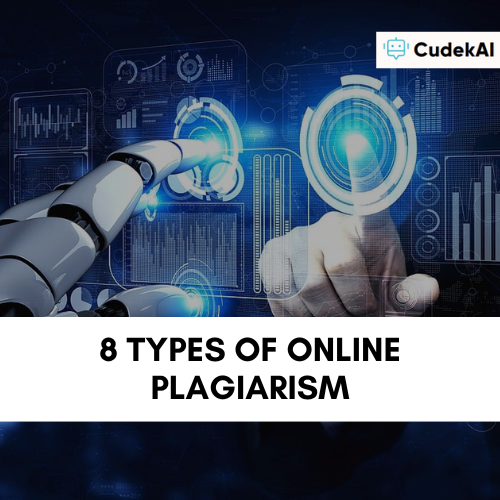As a student, content creator, researcher, or professional in any field, an online plagiarism checker is an essential tool. Plagiarism detectors like Cudekai help you catch the content that is plagiarized or in other words, the property of someone else.
Plagiarism is copying someone else’s content the same as it is without letting them know. In most situations, it is done intentionally, and in a few cases, authors accidentally do it.
8 most common types of plagiarism

If we have a look at plagiarism from a wider angle, there are 8 most common types of plagiarism.
Complete plagiarism
It is the most dangerous form of plagiarism when a researcher presents someone else’s information or study and submits it with his name. This comes under theft.
Source-based plagiarism
This happens when there is a plagiarism error due to a wrong attribution of information source. To explain further, think of yourself as a researcher. While constructing an essay or any form of writing, you have collected information from a secondary source but have only cited the primary source. This ends up in secondary source plagiarism when the source provided is not the original from which you have taken the information. It is due to misleading citations.
Direct plagiarism
Direct plagiarism is a form of plagiarism when the author uses someone else’s information, with each word and line, and passes it as her or his data. It comes under complete plagiarism and is done through the sections of another’s paper. This is completely dishonest and breaks ethical guidelines.
Self- or auto-plagiarism
Another form of online plagiarism is self-plagiarism. This happens when an author reuses his previous work without attribution. It is done mainly among the published researchers. Academic journals usually are strictly prohibited from doing this.
Paraphrasing plagiarism
Paraphrasing plagiarism is defined as repeating the content of others and rewriting it with different words. This is one of the most common types of plagiarism. It is considered plagiarism because the original idea behind the content remains the same. If you are stealing someone else’s idea, it will be categorized as plagiarized content as well.
Inaccurate authorship
Inaccurate authorship comes in two ways. One is when someone gives his or her part in the construction of a manuscript but does not get credit. Another form is when an individual gets credit without doing anything. This is prohibited in the research sector.
Accidental plagiarism
Here comes the 7th type of online plagiarism. Accidental plagiarism is when someone copies your content accidentally. It can happen unintentionally and without knowledge. Students and writers usually end up committing this kind of plagiarism.
Mosaic plagiarism
Mosaic plagiarism is when a student or anyone uses phrases from the authors without using quotation marks. He uses synonyms for the quotes but the original idea is the same.
Why is it important to keep the plagiarism check?
Plagiarism checking is important to produce original content that is high in quality. As a writer, student, researcher, or any professional, you must aim to create content that is unique and creative and is produced using your ideas and brainstorming. In this fast-paced world, it has become easier due to the advent of plagiarism detectors like Cudekai. This tool will improve your writing skills, save you time while being extra fast, and help you meet deadlines. It speeds up your revision and final editing processes. You will not have to go through hundreds of web browsers to check for plagiarism. Along with getting your credibility enhanced, avoiding plagiarism means avoiding legal issues. If we think of it deeply, this is a huge sin, breaking the rules and ethical guidelines. No matter who you are or what your career is, it is not allowed.
How does an online plagiarism detector work?
Plagiarism detectors use advanced algorithms and database software to make detailed checkups. With commercial plagiarism checkers, you can even check your content before publishing or submitting it. Your text is scanned for similarities after the tool browses through web content. After this process, Cudekai or another plagiarism detector will highlight the plagiarized text. In the end, you will be provided with probably a percentage of the text that is plagiarized, and the sources are listed as well.
Are you rewriting the plagiarized text again and again, but it still shows plagiarism? Our free AI plagiarism remover will remove all your worries and make your process easier and less hectic. Just paste the content you want a new version of and choose basic or advanced mode. The tool will provide the outputs according to your preferences and customizations. With the number of credit costs available, you can rewrite the text again, in case you do not like it.
Once completed, recheck for plagiarism with the help of a plagiarism detector, and make sure your content is completely original and not linked to any of Google’s sources.
Conclusion
Plagiarism detection plays a significant role in our lives. No matter which form of it you are committing, it will be wrong and against the code of conduct. This is when a plagiarism detector comes in and helps streamline your workflow. Let Cudekai check your content so you can publish it with complete satisfaction.